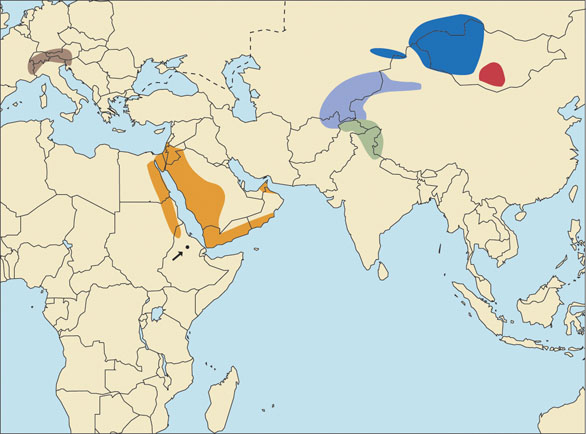 |
 |
Capra sibirica alaiana
Sometimes called Tian Shan ibex, although this describes only part of this animal's range.
DESCRIPTION This subspecies can be the largest in size and grow the largest horns. Males can weigh as much as 285 pounds (130 kg), or even more.
Its coloration is very different from that of the Siberian and Gobi ibexes. In winter coat, most adult males are a cinnamon-brown color of varying intensity, becoming browner and duller on the flanks, shoulders and thighs. There usually is a dark, well-developed dorsal stripe, and also a light-colored saddle patch that can vary in size, shape and location. A very dark flank band separates the brown flanks from the whitish belly. There is a distinct brown band on the front surface of the forelegs, a lighter one on the hind legs. The head is lighter than the flanks-actually somewhat grayish-and the beard is brown. However, there is a good deal of individual variation in color and markings. Some animals are darker or lighter, and some are a uniform light gray color. The dorsal stripe may be wide, narrow, or absent entirely. The saddle patch may be light or dark, large or small, on the neck or shoulder instead of the small of the back, absent entirely, or there may be more than one patch. Females seldom if ever have a saddle patch.
Regional variation also occurs. Ibex from the Alai Mountains in Tajikistan (alaiana race) have been described as light grayish-brown in summer, with a dark dorsal stripe but no saddle patch; and bright foxy red in winter, with a distinct light saddle patch. Those from the Terskey-Ala-Too range in Kyrgyzstan (almasyi race) have been said to be reddish-brown-fawn in summer, with distinct light saddle and neck patches and tending to gray on the head; turning to some shade of grayish-brown in winter, with a broad dark dorsal stripe and small, dark saddle and neck patches. Horns very long and relatively slender with comparatively small cross ridges. Ibexes of the Naryn district in Kyrgyzstan (merzbacheri race) are stated to differ from almasyi by lighter coloration, a more distinctly defined dorsal saddle and much shorter, more divergent and more heavily knotted horns. However, none of these descriptions is consistent with the region or even within the herd.
DISTRIBUTION The Pamir, Alai, Transalai and Tian Shan mountains in Afghanistan, Tajikistan, Kyrgyzstan, Kazakhstan, and China.
TAXONOMIC NOTES Includes the following races: alaiana, almasyi, merzbacheri, and transalaiana, with alaiana Noack, 1902 having priority.
|





